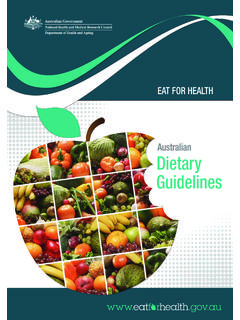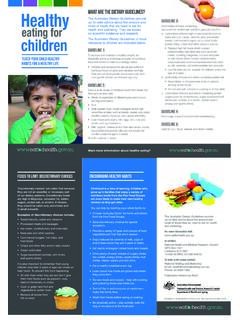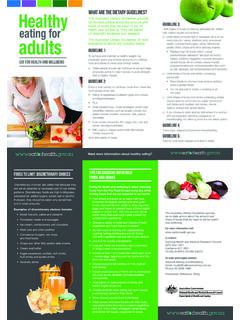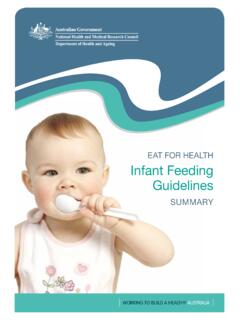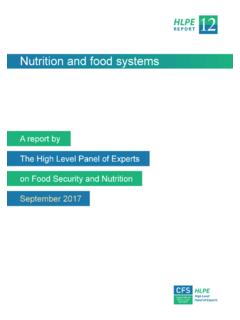Transcription of how to understand food labels - Eat For Health
1 How to understand food labelsWhat to look t rely on Health claims on labels as your guide. Instead learn a few simple label reading tips to choose healthy foods and drinks, for yourself. You can also use the label to help you lose weight by limiting foods that are high in energy per serve. 100g Column and Serving SizeIf comparing nutrients in similar food products use the per 100g column. If calculating how much of a nutrient, or how many kilojoules you will actually eat, use the per serve column. But check whether your portion size is the same as the serve how many kJ per serve to decide how much is a serve of a discretionary food , which has 600kJ per sugar completely is not necessary, but try to avoid larger amounts of added sugars.
2 If sugar content per 100g is more than 15g, check that sugar (or alternative names for added sugar) is not listed high on the ingredient Fat Generally choose foods with less than 10g per milk, yogurt and icecream, choose less than 2g per cheese, choose less than 15g per Fat Aim for the lowest, per 100g. Less than 3g per 100g is (Salt)Choose lower sodium options among similar foods. food with less than 400mg per 100g are good, and less than 120mg per 100g is Listed from greatest to smallest by weight. Use this to check the first three ingredients for items high in saturated fat, sodium (salt) or added names for ingredients high in saturated fat: Animal fat/oil, beef fat, butter, chocolate, milk solids, coconut, coconut oil/milk/cream, copha, cream, ghee, dripping, lard, suet, palm oil, sour cream, vegetable names for added sugar.
3 Dextrose, fructose, glucose, golden syrup, honey, maple syrup, sucrose, malt, maltose, lactose, brown sugar, caster sugar, maple syrup, raw sugar, Not all labels include fibre. Choose breads and cereals with 3g or more per serveNutrition InformationServings per package 16 Serving size 30g (2/3 cup)Per servePer : Cereals (76%) (wheat, oatbran, barley), psyllium husk (11%), sugar, rice, malt extract, honey, salt, vitamins. Other names for high salt ingredients: Baking powder, celery salt, garlic salt, meat/yeast extract, monosodium glutamate, (MSG), onion salt, rock salt, sea salt, sodium, sodium ascorbate, sodium bicarbonate, sodium nitrate/nitrite, stock cubes, vegetable salt.
